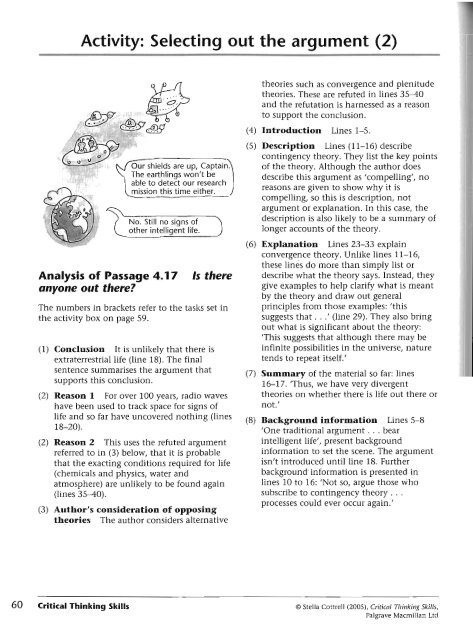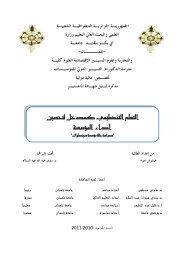Critical Thinking Skills - Developing Effective Analysis and Argument(2)
Critical Thinking Skills - Developing Effective Analysis and Argument(2)
Critical Thinking Skills - Developing Effective Analysis and Argument(2)
You also want an ePaper? Increase the reach of your titles
YUMPU automatically turns print PDFs into web optimized ePapers that Google loves.
Activity: Selecting out the argument (2)<br />
ur shields are up,<br />
The earthlings won't be<br />
\ able to detect our research<br />
\_mission this time either.<br />
other intelligent life.<br />
<strong>Analysis</strong> of Passage 4.17<br />
anyone out there<br />
Is there<br />
The numbers in brackets refer to the tasks set in<br />
the activity box on page 59.<br />
(1) Conclusion It is unlikely that there is<br />
extraterrestrial life (line 18). The final<br />
sentence summarises the argument that<br />
supports this conclusion.<br />
(2) Reason 1 For over 100 years, radio waves<br />
have been used to track space for signs of<br />
life <strong>and</strong> so far have uncovered nothing (lines<br />
18-20).<br />
(2) Reason 2 This uses the refuted argument<br />
referred to in (3) below, that it is probable<br />
that the exacting conditions required for life<br />
(chemicals <strong>and</strong> physics, water <strong>and</strong><br />
atmosphere) are unlikely to be found again<br />
(lines 3540).<br />
(3) Author's consideration of opposing<br />
theories The author considers alternative<br />
theories such as convergence <strong>and</strong> plenitude<br />
theories. These are refuted in lines 35-40<br />
<strong>and</strong> the refutation is harnessed as a reason<br />
to support the conclusion.<br />
(4) Introduction Lines 1-5.<br />
(5) Description Lines (1 1-16) describe<br />
contingency theory. They list the key points<br />
of the theory. Although the author does<br />
describe this argument as 'compelling', no<br />
reasons are given to show why it is<br />
compelling, so this is description, not<br />
argument or explanation. In this case, the<br />
description is also likely to be a summary of<br />
longer accounts of the theory.<br />
(6) Explanation Lines 23-33 explain<br />
convergence theory. Unlike lines 11-16,<br />
these lines do more than simply list or<br />
describe what the theory says. Instead, they<br />
give examples to help clarify what is meant<br />
by the theory <strong>and</strong> draw out general<br />
principles from those examples: 'this<br />
suggests that . . .' (line 29). They also bring<br />
out what is significant about the theory:<br />
'This suggests that although there may be<br />
infinite possibilities in the universe, nature<br />
tends to repeat itself.'<br />
(7) Summary of the material so far: lines<br />
16-17. 'Thus, we have very divergent<br />
theories on whether there is life out there or<br />
not.'<br />
(8) Background information Lines 5-8<br />
'One traditional argument. . . bear<br />
intelligent life', present background<br />
information to set the scene. The argument<br />
isn't introduced until line 18. Further<br />
background information is presented in<br />
lines 10 to 16: 'Not so, argue those who<br />
subscribe to contingency theory. . .<br />
processes could ever occur again.'<br />
60 <strong>Critical</strong> <strong>Thinking</strong> <strong>Skills</strong><br />
I<br />
0 Stella Cottrell (ZOOS), <strong>Critical</strong> Tlzinking <strong>Skills</strong>, I<br />
Palgrave Macmillan Ltd



